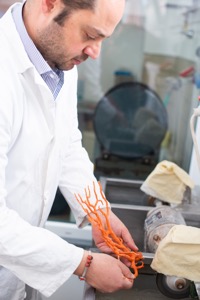 Raw coral is by nature a compound of heterogenic branches.
Raw coral is by nature a compound of heterogenic branches.
Before working on the coral, an accurate selection is necessary and fundamental for fine productiveness. The coral cannot be cut like we want it, moreover we must cut the coral the way it wants to be cut, this said, our decisive working field is tightly limited.
After examining the particular characteristics of each single piece, the pieces are then regrouped together in a way that allows “la Tagliatura” (the cutting or incision process).
Work on the coral is divided into two types:
• Carving or artistic work producing a miniature figurative scene or subject of a varied kind.
• Plane or technical work (also called noble art) producing pieces with smooth surfaces like Cabochon (a specific type of shape where the top is curved and the base is flat) or creating ball-like containers for assembling, necklaces, earring, rings, pins, etc…
Both methods start off with the same productive process called, “the cut” which is carried out by a machine called “il rotino” (the cutting wheel), This machine pitches a very thin diamond blade in the form of a disc that cuts the coral branches.
By means of this process, the log of the coral is segmented as to obtain a pre-shaped form which subsequently becomes enlarged with a “molatrice” (a grinder machine), this machine pitches out an abrasive polisher that eliminates imperfections and gives the coral a pre-established form.
If the coral is imperfect than a specific carving will be made by help of motored handles or knobs, if the quality of the coral is homogeneous than it’s destined to produce smooth products, in this case, one of two methods are used according to the desired carving: Small balls or other melted pieces. If the production has to do with the small balls, after giving them an approximate spherical shape with the grinder machine, the carving is perfected with “la rociatura” (circle forming process) with the machine called “macchina dei pallini” (the beads machine). However, if the production has to do with other melted pieces (for example, cabochon or buttons), after being abrasively polished with the grinder machine, the pieces are then stuck on spinning sticks made of wood that spin rapidly; moulding the surface and perfecting the cut.
After these substantial manual phases, another moulding procedure is carried out on the pieces making them spin for a couple of hours in an octagonal keg called “buratto” (shining machine) with flakes of coral and pumice. Afterwards, holes are made into the pieces with horizontal or vertical drilling machine. Then they are polished with a pewter brush or with a keg that contains a specific neutral soap and a chemical substance called “polimento”.

